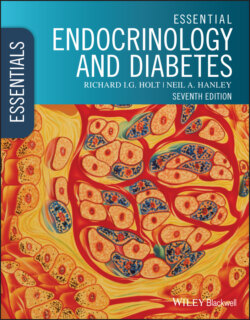Читать книгу Essential Endocrinology and Diabetes - Richard I. G. Holt - Страница 76
Nuclear localization, DNA binding and transcriptional activation
ОглавлениеIn their resting state, unbound steroid hormone receptors associate with heat‐shock proteins, which obscure the DNA‐binding domain and prevent binding to target DNA sequences in the genome. Steroid binding causes conformational change, the dissociation of the heat‐shock proteins and reveals two polypeptide loops stabilized by zinc ions that are known as zinc fingers. Once two steroid receptors have dimerized, these zinc finger motifs bind to target DNA at the specific hormone response element (HRE) (Figure 3.20).
Prior to hormone binding, the thyroid hormone receptor (TR) is located in the nucleus and can bind to DNA at the thyroid hormone response element (TRE). In the absence of hormone, the TR dimerizes with the retinoid X receptor and tends to recruit nuclear proteins that inhibit transcription (co‐repressors). Binding of thyroid hormone causes dissociation of these factors in favour of association with transcriptional co‐activators, and a sequence of events that results in the recruitment of DNA‐dependent RNA polymerase and gene transcription (Figure 3.20 and Figure 2.2).
Resistance syndromes for nuclear hormone receptors are similar to those for cell‐surface receptors. Inactivating mutations reduce or abolish receptor function. This can occur by a range of mechanisms, such as reduced hormone binding, impaired receptor dimerization or decreased binding to the HRE. Ultimately, this tends to reduce negative feedback and raise circulating hormone levels. The latter are frequently a diagnostic pointer for hormone resistance syndromes (Table 3.3).
